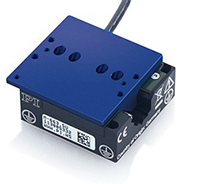

The working principle of ultrasonic piezo motors, coupled with their low inertia, give them very fast response times, with maximum velocities up to 500 mm/s (600 – 800 deg/s for rotary motion) and accelerations of 10 to 20 g.

This friction does offer an advantage, though, in the form of a holding force when no power is applied. However, their reliance on friction between the stator and the rotor (or between the pusher and the slider, in the case of a linear motor), limits their resolution to 50 – 80 nm. Ultrasonic piezo motors are direct drive mechanisms, meaning they have no mechanical couplings or gears to induce backlash. A standing wave is formed when an incident (original) and a reflected wave interfere in such a way that there are points along the medium that appear to not be moving, or to be standing still. Ultrasonic piezo motors are sometimes called “standing wave piezo motors,” due to the type of wave generated when the piezoelectric material is excited. In a standing wave formation, the blue and green waves interfere to form the standing (black) wave. The pusher is in contact with a slider and causes it to move linearly. A coupling, or “pusher,” is attached to the plate, and the plate’s oscillations cause the pusher to move along an inclined path at the same frequency. When a voltage is applied, the plate is excited at its resonance frequency, which causes it to oscillate. Operating principle of a linear piezo motorįor linear motion, a piezoelectric plate replaces the traditional stator. As the wave progresses, the rotor travels in the opposite direction of the wave’s motion. The vibrations in the stator form a wave of motion, and only the peaks of the wave make contact with the rotor. The rotor is pressed against the stator, with the friction material between them, and rotation is induced in the rotor by the interaction of these surfaces. When a voltage is applied to the stator, the piezoelectric material is excited and produces ultrasonic vibrations in the stator. Construction and operation Cutaway of a rotary ultrasonic piezo motorįor rotary motion, the piezo motor is composed of a stator that incorporates piezoelectric materials, a friction component, and a rotor. Their design and operation are relatively simple but allows them to achieve very high accelerations and speeds, and to produce high holding forces when no current is applied. Ultrasonic piezo motors harness oscillations induced in a piezoelectric material to produce motion, which can be either rotary or linear.


 0 kommentar(er)
0 kommentar(er)
